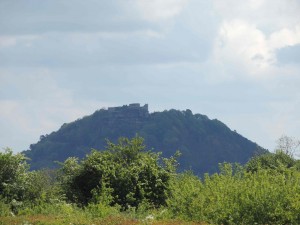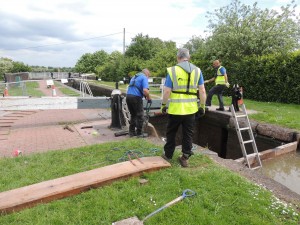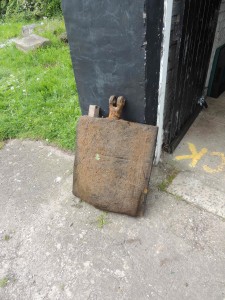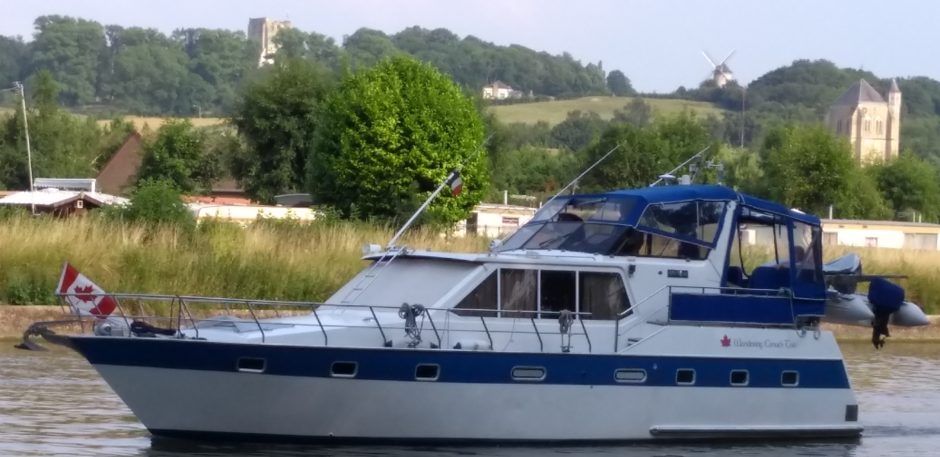Well, today was an adventure of a different sort, albeit still on the canal and boating. I stayed overnight in the shadow of Beeston Castle (the ruins thereof).
 There was a quaint hotel/inn/pub mentioned in the guide book (my book is 5 yr old- the pub burnt down 4yr ago). The start of an interesting (?) time. I wandered according to directions from others to the next place with a pub (now a laundry), and then to the next place (now 4km walking). Tarporley. A nice village, with lots of amenities, and a great Indian food pub conversion. Tried that. Great!Then back to the boat- and found that the rail line was under repair. British rail lines are SO much quieter than Canadian, I don’t really mind mooring near them, but this was intermittent loading of a rail car with large gravel stones, then screeching brakes, and… This ended by 9pm, so not a big deal. Then I discovered that the WW2 fortifications across the rail track, are also used as a deer farm, and the deer came out to feed in the twilight. Scores of deer. It was neat, amongst the fortifications from this fuel storage place (according to the guidebook).
There was a quaint hotel/inn/pub mentioned in the guide book (my book is 5 yr old- the pub burnt down 4yr ago). The start of an interesting (?) time. I wandered according to directions from others to the next place with a pub (now a laundry), and then to the next place (now 4km walking). Tarporley. A nice village, with lots of amenities, and a great Indian food pub conversion. Tried that. Great!Then back to the boat- and found that the rail line was under repair. British rail lines are SO much quieter than Canadian, I don’t really mind mooring near them, but this was intermittent loading of a rail car with large gravel stones, then screeching brakes, and… This ended by 9pm, so not a big deal. Then I discovered that the WW2 fortifications across the rail track, are also used as a deer farm, and the deer came out to feed in the twilight. Scores of deer. It was neat, amongst the fortifications from this fuel storage place (according to the guidebook).
I hung the bell on the bow of the boat, and installed clapper, and method of ringing from the stern.

paddle removal at Cholmondeston Lock. Note stop planks on right blocking water so they could climb down to replace the paddle

the worn elm wood paddle. Gouge on right allowed paddle to fall out of track, preventing the paddle from stopping the water flow.
Today, I intended to travel across the Middlewich branch to Middlewich. I had been working the locks with 2 couples from Australia, and getting to chat with them was great. We turned the corner onto the Middlewich Branch, and at the first lock at Cholmondeston which is a narrow lock (only one boat at a time) had the upper paddle fall out of it’s track, therefore preventing it closing, which meant that it was VERY difficult and slow to operate the locks. There were 8 boats in the lineup (queue, in Britain). The engineers were there, and tried to solve the problem, then simply plugged the paddle hole temporarily, until they could get all the people and parts together, and have their lunch. Boats slowly made their way through, each boat taking at least double the time. Down to 1 boat ahead of me, then the workers sprang into action, and blocked off the lock completely, so they could drain the water from the offending area, and effect a replacement of the paddle. You can just see the old one at the feet of the one worker. They are made of elm wood, which is hard, doesn’t rot underwater, and is self-lubricating when wet. However, sliding up and down hundreds of times in a steel track does wear at the wood, and you can see the gouges along the right hand side. In any case, old paddle out, another old one they had as spare, in, and an hour later, the lock was working at normal speed. Really only held me up for about 2.5h, and I had a chance to have lunch with the Auzzies (thanks!), chat about stuff, and observe. It was an adventure- which is what I am here for. There WERE some annoyed folk, but I just thought it an interesting variation of a day on the canal- and it was a nice day- no rain, and scattered clouds. T-shirt weather for the first time, really.
I am in Middlewich, where I hope to spend a couple of days doing more boat stuff, and trying to decide what to do with the car. All good.


1 Response to May 15